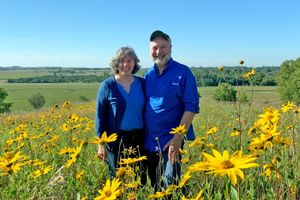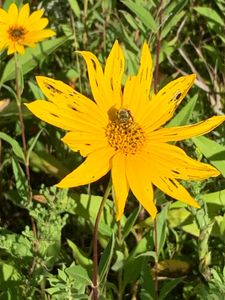Scott and Kate Schaefers Honored for Wildlife Stewardship
 In 1861, ProAg Senior Vice President of Marketing Scott Schaefers’ great-grandparents arrived as homesteaders in Stearns County, Minnesota. Four generations later, Scott and his wife, Kate, work hard to honor that legacy through conservation and habitat restoration on the family’s original homestead. Their work has resulted in 157 acres of restored tallgrass prairie — and recognition as the 2022 Stearns County Wildlife Habitat Stewards.
In 1861, ProAg Senior Vice President of Marketing Scott Schaefers’ great-grandparents arrived as homesteaders in Stearns County, Minnesota. Four generations later, Scott and his wife, Kate, work hard to honor that legacy through conservation and habitat restoration on the family’s original homestead. Their work has resulted in 157 acres of restored tallgrass prairie — and recognition as the 2022 Stearns County Wildlife Habitat Stewards.
Presented by the Stearns County Soil & Water Conservation District, the award honors individuals or organizations working hard to protect and enhance local wildlife habitats. It was established in 2022, making Scott and Kate the first to receive the accolade.
“Kate and I are proud to continue our family’s legacy of caring for the land,” said Scott. “For us, restoration is about protecting this space so it can flourish for future generations.”
A look back at their restoration work
Scott and Kate began their restoration work more than 20 years ago by enrolling portions of the farm in the Conservation Reserve Program (CRP). Since then, the couple has worked to redevelop native prairie with the Stearns County Soil & Water Conservation District. More than 150 acres have already been converted with a diverse mix of more than 40 species of native grasses and flowers. The couple says they’ve seen additional species emerge after rotational controlled burns that help keep the habitat in good shape. They also intend to interseed an additional 47 acres with even more species this year.
Beyond their work to reestablish prairie, Scott and Kate have found other ways to boost biodiversity and support native species on their land. Across 20 acres of drained wetlands, the couple partnered with U.S. Fish and Wildlife to break up old drainage tile and create eight wetland restorations. They’ve also worked to give pollinators a place on the property with five acres of habitat created in 2022.”\n\r” According to the Stearns County Soil & Water Conservation District, the project helps improve local water quality, offers pollinators much-needed food and habitat, and provides natural beauty. The results of their work are all around them on the farm in increased deer, pheasant, turkey, pollinator and prairie plant populations. As they continue to expand conservation efforts, their legacy will likely continue to grow through additional biodiversity.
According to the Stearns County Soil & Water Conservation District, the project helps improve local water quality, offers pollinators much-needed food and habitat, and provides natural beauty. The results of their work are all around them on the farm in increased deer, pheasant, turkey, pollinator and prairie plant populations. As they continue to expand conservation efforts, their legacy will likely continue to grow through additional biodiversity.
Though Scott and Kate are the fourth generation to care for the land, they certainly won’t be the last. As part of their conservation work, they enrolled in the Conservation Reserve Enhancement Program (CREP) to help permanently protect the entire farm as natural habitat. As a result, more than 260 acres of land will remain undeveloped and full of life in perpetuity.
“I think the real main message here is that this place has just been so central to our lives, as well as previous generations,” Kate said to Stearns County Soil & Water Conservation District in an interview. “We have really wanted to honor all those generations in creating this environment that reflects us because we value this habitat. We also know previous generations valued this habitat in a similar way.”
“We really are looking at what we want this land to be. We’ve invested so much of our lives into transforming this into a beautiful prairie and bringing it back. We’re also thinking about what we want to leave for future generations,” she continued.
Living ProAg values
Conservation is essential to agriculture, helping protect soil health and water quality that directly impact crops, livestock and communities. Scott’s work is just one example of ProAg team members going above and beyond to protect our natural resources.
“It’s wonderful to see the care Scott and Kate have for their family farm,” said Kendall Jones, ProAg president and CEO. “Their work embodies the innovation and eye for sustainability that drives so many farmers and ranchers across the nation. Everyone at ProAg is incredibly proud of their stewardship award.”
Scott and Kate shared their gratitude for the many partners who have helped them transform the land. Their collaborators include Pheasants Forever, Farm Service Agency (FSA), Stearns County Soil & Water Conservation District and Minnesota Habitat Management.
For producers looking to implement conservation strategies, the USDA Risk Management Agency (RMA) offers incentives to reward agricultural producers for their efforts, including cover crops, split application and irrigation efficiency.
